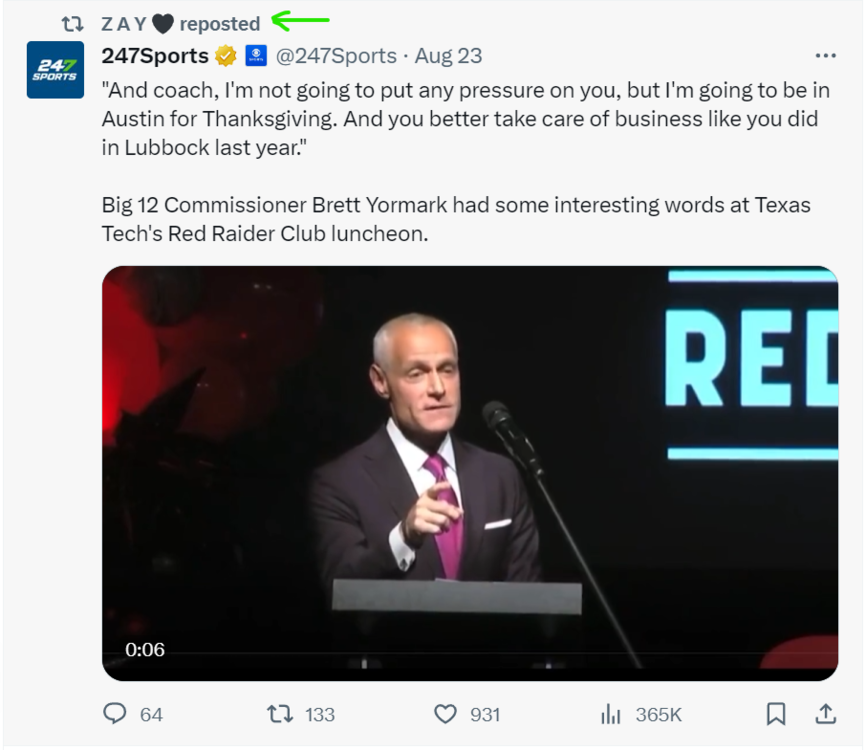-
Posts
694 -
Joined
-
Last visited
Content Type
Profiles
Forums
Store
Downloads
Recruiting - 2020
2019-2020 Football Season
Football
Entertainment
Sports
News and Business
Cloak Room
Transfer Portal
Recruiting
Events
Posts posted by Kwix
-
-
30 minutes ago, Js1 said:
Texas was very smart to start "low" and let Sark prove himself first. 5 wins -> 8 wins -> 10+ wins will get him a nice bump of 2-3 million and into the top 15/20.
Seeing that stoops, heupel and kiffin all make 9, I'd be surprised if sark isn't above that next year.
-
31 minutes ago, Helobious said:
I miss when it was just straight up North/ South division winners playing.
Yeah, cause a tiebreaker never screwed us back then.
-
 1
1
-
 2
2
-
-
1 hour ago, alphahydro said:
this is how i read it, assuming the only scenario at issue is TX, OU, and OSU being tied for first, with ISU being highest ranked common opp for all 3.
There are two sections to the rules -
Section 1 addresses a two way tie (could be a tie for first (two teams at 11-0; issue is seeding) or a tie for second (one team at 11-0; two teams at 10-1; issue is which of the two 10-1 teams get in).
Section 2 addresses a 3+ team tie (three+ teams at 10-1; issue is which two teams get in)
With 3+ teams (TX, OU, & OSU) tied for first, we start in Section 2.
When you run through the Section 2 tiebreaker rules, the first tiebreaking rule doesn't apply because TX, OU, and OSU didn't all play each other.
The second tiebreaking rule is record vs next highest common opponent (ISU). Against ISU, Texas and OU are 1-0; OSU is 0-1.
Section 2 says
After one team has an advantage and is “seeded”, all remaining teams in the multiple-team tiebreaker will repeat the multiple-team tie-breaking procedure. If at any point the multiple-team tie is reduced to two teams, the two-team tie-breaking procedure will be applied.
What Alex Loeb seems to be arguing is that after applying the ISU tiebreaker, you then apply the ORANGE SENTENCE to resolve the remaining two-team tie between TX and OU (per Alex - OU wins that one on head to head) - then you go back and re-run tiebreaking rules between OSU and TX, because all that happened in round 1 of tiebreaking was that OU was seeded #1.
He's wrong.
In the Big XII tiebreaking scheme, the only way to apply the TX vs OU head-to-head tiebreaking rule at this point would be to apply the ORANGE SENTENCE and go to Section 1 tiebreaking rules to resolve TX vs OU. But if you go to to Section 1, it says "if two teams are tied for first place both teams will participate in the championship game and the winner of the head-to-head will be the #1 seed." Boom. Done. End of story.
You just can't go that route. Under these particular rules, you can't get from (a) using the ISU tiebreaker in part 2 of Section 2 to eliminate OSU, to (b) applying a head-to-head tiebreaker to resolve TX vs OU without (c) putting TX and OU in the championship game. (He might also be thinking that once you get rid of OSU through the ISU tiebreaker, you go back to part 1 of Section 2 to resolve TX/OU, but there is nothing in the rules that supports this reading.)
At best, Loeb could argue that the ORANGE SENTENCE does not apply after the ISU tiebreaker, because even though OSU lost the Section 2 step 2/ISU tiebreaker, the three-way tie hasn't been reduced to two teams for some reason. (This is a terrible misreading based on the phrase IF AT ANY POINT). I can't imagine what the words IF AT ANY POINT could mean here if they wouldn't apply after the ISU tiebreaker.
I think the problem is someone at the Big XII read the rules too quickly and didn't "run water through the pipes" (or maybe I am an idiot). They are reading the rules to say, after a tiebreaking rule eliminates one team, you start from the top with the remaining two teams to find the first place team, then start from the top again with the remaining teams. But the words don't say that at all. What they say is:
If you start with four+ teams and get to a tiebreaking rule in section 2 where Team A wins over all the others, you re-run the section 2 rules with the remaining 3+. (makes sense - you can't use section 1 rules as they make no sense with 3+ teams)
If you start with three teams and get to a tiebreaking rule in section 2 where Team A wins over all the others, you run the section 1 rules with the remaining 2. (makes sense - down to two teams, you can just run the Section 1 rules)
Our case is a little bit different, it is:
If you start with three teams and get to a tiebreaking rule in section 2 where one team gets eliminated, you run the section 1 rules with the remaining 2.
but I still think it makes sense the way the rule is written, given the phrase if at any point.
This it correct. Once the 3 way bumps to the 2 way, those 2 teams are both in. Done.
-
 1
1
-
-
7 minutes ago, troph said:
to be fair, that's the dynamic that makes an audience for sports talk radio and the silly sports talk shows on TV.
I'm going to start reading all his posts in Stephen A Smith voice.
-
 1
1
-
-
-
If you read this whole paragraph together:
"In the event of a tie between more than two teams, the following procedures will be used. After one team has an advantage and is “seeded”, all remaining teams in the multiple-team tiebreaker will repeat the multiple-team tie-breaking procedure. If at any point the multiple-team tie is reduced to two teams, the two-team tie-breaking procedure will be applied."
The logical interpretation is: If 1 team has an advantage, they are in and then start over. If 2 teams have an advantage, they are both in.
-
 1
1
-
-
I really don't think the line "If at any point the multiple-team tie is reduced to two teams, the two-team tie-breaking procedure will be applied." means pick a #1 seed then start over.
The 2 team tiebreakers clearly states "If two teams are tied for first place both teams will participate in the championship game"
-
Ok, I know the conference is saying we haven't clinched but they can't read their own fucking rules.
So in a 3 way tie with Texas, OU, and OSU
Multiple team tiebreaker rules:
Step 1: get skipped because we did not all play each other.
Step 2: Record against the next highest placed common opponent in the standings. (This is ISU, which Texas and OU beat, and OSU lost)
At this point, you read the intro to the multiple team tiebreaker rules:
"If at any point the multiple-team tie is reduced to two teams, the two-team tie-breaking procedure will be applied."
Then you look at the first line of the 2 team tiebreaker rules:
"If two teams are tied for first place both teams will participate in the championship game and the winner of the head-to-head will be the #1 seed."
Seams pretty clear that OU and Texas go in this scenario.
-
 3
3
-
-
Not enough love being given for the pitch on this play
-
 7
7
-
-
-
5 hours ago, Huckleberry said:
No that's not the confusing part. It's very clear that H2H would not be used with those 3.
The confusing part is if the conference decides to first figure out the 1 seed instead of doing the logical thing and eliminating the #3 team and putting the other 2 in the championship game.
In the scenario from the tweet that website assumes OSU is eliminated and locked into #3 position. However, the terribly written and therefore ambiguous tiebreaker rules could be read to say that the next step where OU is the 1 seed is all that is locked in. Then Texas and OSU are analyzed for the second spot. Which would go to OSU because in that comparison OU is the highest placed common opponent.
It would be a ridiculous screwjob which is of course why the Big 12 would try to do it to Texas.
I'm not seeing how OU gets the #1 seed in this scenario.
Step 1 doesn't apply because Texas didn't play OSU.
Step 2 doesn't apply because no common opponent comparison puts 1 team ahead of the other 2.
Step 3 puts Texas in.
People seem to be making up some combination of step 2 and head to head out of thin air.
-
 1
1
-
-
-
-
6 minutes ago, JBJ said:
fify
huh?
-
NSIAP
-
 5
5
-
-
7 minutes ago, Pato del Muerto said:
Pretty sure the rules read that you use the flow path until you determine the 1 seed, then start the path over with remaining tied teams. So yeah.
as opposed to stopping the path when a team is eliminated, assigning the 2 remaining teams as participants, and then using the flow to determine seed (as if seeding fucking matters).
Ok, but if that's the case, wouldn't we fall to rule 3. Win percentage against all common conference opponents (must be common among all teams involved in the tie).
As rule2 doesn't provide a clear #1 seed.
-
-
3 way tie with Texas, OU, OSU:
common opponents
ISU [3 losses] (OSU lost to ISU)
Kansas [4-5 losses] (OU lost to KU)
BYU [7 losses] (all 3 beat BYU)against common opponents with 3 losses (ISU)
Texas (1-0), OU (1-0), OSU (0-1)
The rules get a bit murky here
i) Texas and OU are in OSU is out, and then OU is #1 seed via head to head against Texas.
ii) OSU is out, then OU gets #1 seed via head to head against Texas. Then tiebreaker starts over. OSU is #2 seed via record against common opponent OU.
-

-
 2
2
-
 1
1
-
 1
1
-
-
Great game Defense!!!
-
- Popular Post
- Popular Post
-
23 minutes ago, markstanco said:
Wait. Are you saying your wife will carry a bag of trash from the kitchen out to the garage. Nice fucking humble-brag.
-
 1
1
-
 1
1
-
-
-
 2
2
-
 5
5
-
-
Make sure you have the sound on.
-
 1
1
-








Week 12, 2023; Texas Tech at Texas
in Football
Posted
If only there was already a dedicated thread for talking about that stupid map.